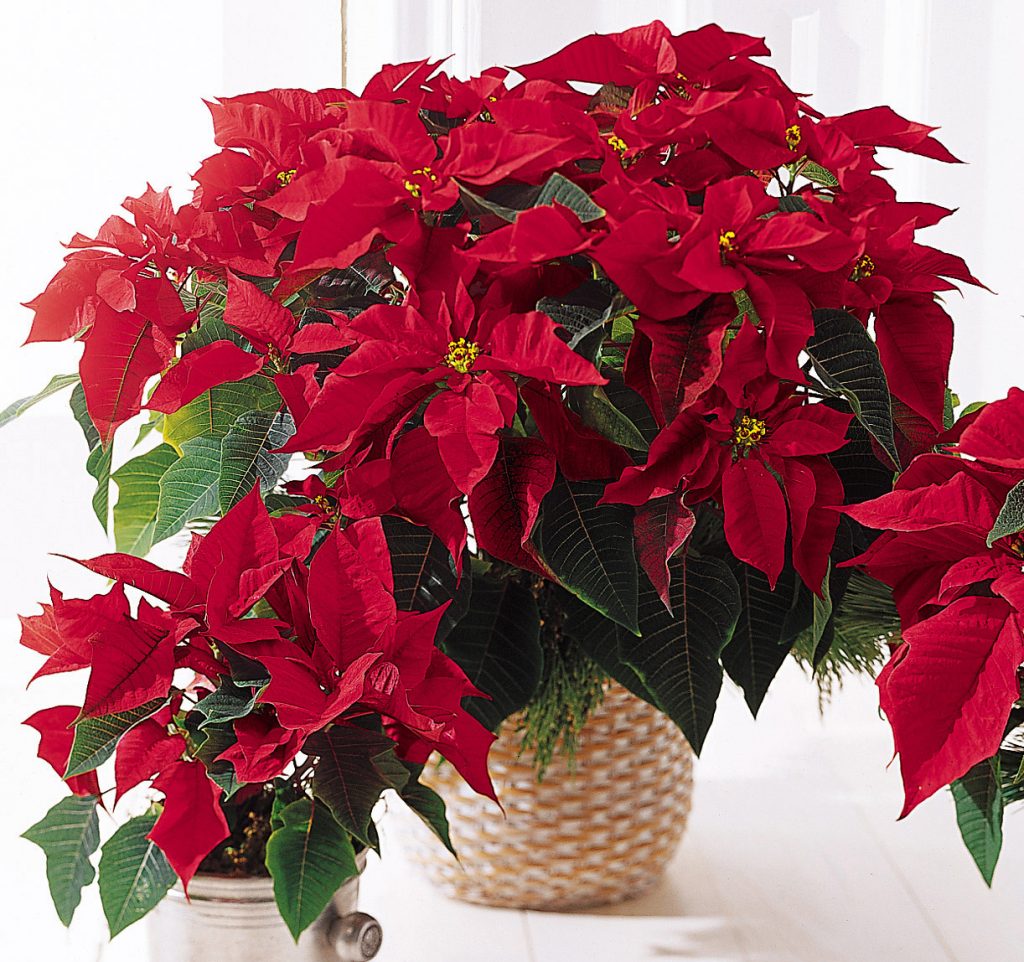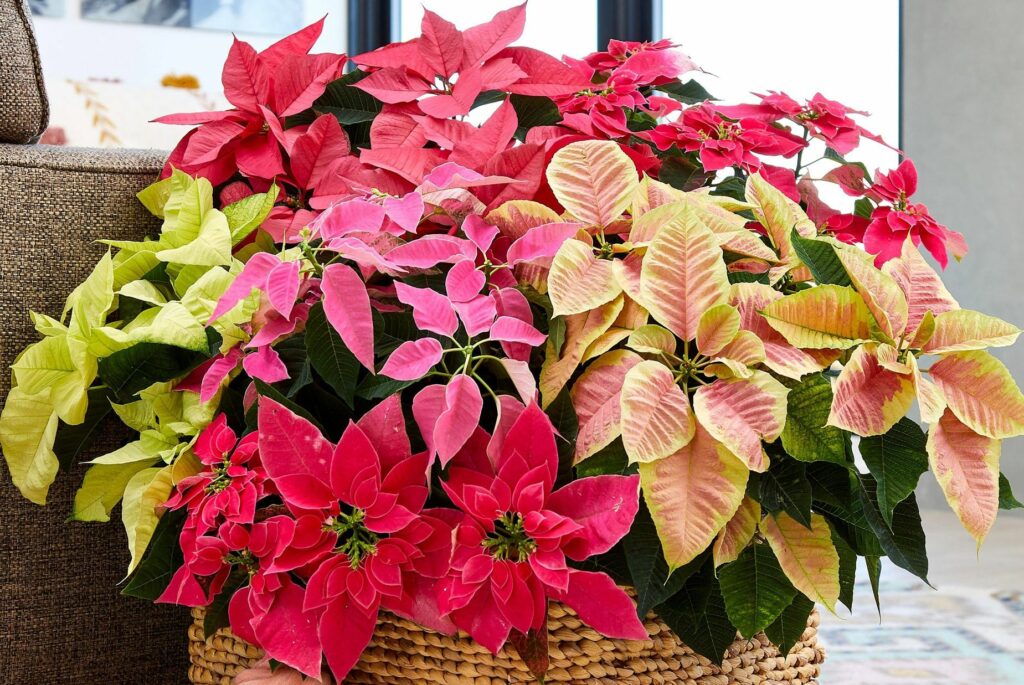by Ken Lain, the mountain gardener

Next to a living Christmas tree, nothing says Christmas like poinsettias. Watters has dozens of colors ranging from traditional shades of red, pink, and white to burgundy, peach, striped, and freckled. They add a festive splash of color to every room and every décor. Perfect as a centerpiece, around the hearth, or any room holiday spirits need lifting. We also offer sizes that make perfect gifts at the office or Christmas party.
FUN POINSETTIA FACTS:
- Poinsettias bloom when the days get shorter.
- The colorful “flowers” of poinsettias are actually modified leaves called “bracts.”
- Poinsettias grow well in moist soil and temperatures between 65 and 70 degrees F.
- They can be grown outdoors during summer.
- Poinsettias are not poisonous, but the sap may cause dermatitis.
Native to Mexico, poinsettias are in the Euphorbia family and are a popular holiday plant because of their colorful bracts (leaves). There is also a species that is used as a cut flower. They are most commonly used for decorating during the winter holidays. They are also attractive as green plants throughout the year.

Poinsettias change color in response to shorter winter days. Poinsettia flowers are actually made up of bracts, which look like petals. The tiny yellow flowers in the center are called cyathia. The colorful bracts attract insects to the flowers and will drop after pollination.
Poinsettias are NOT harmful to animal or human health. But they should not be eaten.
- The sticky white sap can cause a skin rash, so gloves are recommended when working with these plants.
- Avoid contact with eyes and mouth.
- Wash tools well after use as the sap can make tools sticky.
POINSETTIAS COME IN MANY COLORS.
You can find poinsettias around the holidays to fit into almost any decorative scheme. They range from creamy white to pink to the traditional bright red. Some varieties have bracts with red and white patterns, pink and white, or green and white and even bright orange.
Flower forms vary as well, with some looking similar to a rose. You will also find unusually colored poinsettias such as blue or purple in garden centers. These are cream-colored varieties that are spray painted. They are sometimes sprinkled with glitter.
Light and temperature
- Indoor light: Put in a south, east, or west window where the plant will receive bright daylight.
- Outdoor light: Part sun, 4 to 6 hours daily.
- Temperature:
- Indoor temperatures of 65-70 degrees F is ideal.
- Avoid placing poinsettias where the temperature fluctuates or drying, such as near cold drafts, heat ducts, fireplaces, fans, space heaters, etc.
- Poinsettias will suffer damage if they are exposed to temperatures below 50 degrees F.
- Freezing temperatures kill poinsettias.
Watering
- Keep soil moist.
- Water plant when the soil surface feels dry to a light touch or pot feels lightweight when lifted. Never allow poinsettias to get so dry that they wilt.
- Remove from decorative foil or outer pot before watering.
- Make sure your plant is in a pot that drains freely.
- Set plant in a sink and water thoroughly, allowing the plant to drain completely.
- Never allow poinsettia pots to sit in excess water. Constant wetness will rot plant roots.
- Continue watering as needed from January through March.
Fertilizing
- You do not need to fertilize your poinsettia during the holidays.
- Start fertilizing your plant when you see new growth (new green leaves, stems, bracts).
- Fertilize with Watters Root & Grow plant food.
- Mix with water at half the recommended strength.
- Feed your poinsettia monthly to keep the plant healthy and provide the necessary nutrients for new growth.
Transplanting
- In late spring or early summer, transplant your poinsettia into a larger container (about 2 to 4 inches bigger than the original pot) or into a part-sun garden bed.
- In pots, plant directly into Watters Potting Soil for best results. Make sure your new pot has a drainage hole at the bottom.
- In the garden, plant into a garden bed with well-drained soil that gets 4 to 5 hours of sun per day. Blend a 2-3″ inch layer of Watters Premium Mulch into your garden soil to ensure proper drainage. This will help maintain soil moisture and create an excellent growing environment for the roots.
- Water your poinsettia thoroughly after transplanting with Watters Root & Grow to reduce transplant shock.
POINSETTIA CARE AFTER THE HOLIDAYS AND REBLOOMING
“How can I make my poinsettia rebloom?” is a common question.
Poinsettias can be grown as attractive green plants. Most gardeners are interested in making their green poinsettia colorful again and ready for the next holiday season.
It is not an easy task, as it requires excluding light from the plant while keeping the plant healthy. The reduction in light prevents the plant from producing chlorophyll, the pigment that makes plant parts green. This changes the bracts to red, pink, or white, depending on the poinsettia variety.
Dr. Leonard Perry, Extension professor emeritus at the University of Vermont and author of Caring for Your Poinsettia Year-Round, developed an easy-to-follow poinsettia care calendar on the holidays of the year.
New Year’s Day
- Fertilize with Watters Root & Grow when you see new growth.
- Continue to provide adequate light and water for a prolonged bloom for several weeks.
Valentine’s Day
- Check your plant for signs of insects, such as whitefly. Spray with Watters Triple Action Neem oil at first sign of bubs.
- If your plant has become long and leggy, cut back to about five inches tall to promote more compact growth.
St. Patrick’s Day
- Prune off faded and dried parts of the plant.
- Remove leaves from the soil surface, and add a little more potting soil if the roots are visible.
- Continue keeping the plant in a bright, sunny window.
Memorial Day
- Trim off two to three inches of branches to promote side branching. If you plan to continue growing your poinsettia as a potted plant, transplant it into a container.
Father’s Day
- Move the plant outside for the summer and place it in indirect light. You can also transplant it directly into your garden.
Fourth of July
- Trim the plant again.
- Move it into full sun.
- Continue to water and fertilize but increase the amount to accelerate growth.
Labor Day
- Move indoors to a spot that gets at least six hours of direct light daily, preferably more.
- As new growth begins, reduce the fertilizer to one-quarter the recommended strength.
Fall equinox
- Starting on or near Sept. 21, give the plant 16 hours of uninterrupted darkness (put the plant in a closet, basement, or under a box) and 8 hours of bright light every day.(Note that during the dark period, the plant cannot receive even the slightest bit of light at any time.)
- Maintain night temperatures in the low 60 degrees F range.
- Continue to water and fertilize at a reduced rate.
- Rotate the plant daily to give all sides even light.
Thanksgiving
- Discontinue the short day/long night treatment.
- Put the plant in a sunny area that gets at least six hours of direct light.
- Reduce water and fertilizer.
Christmas
Enjoy your “new” poinsettia. Start the cycle all over again after the new year.

